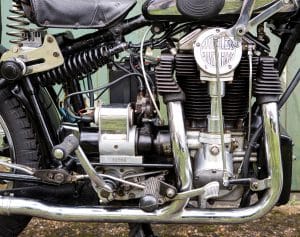The Associated Motor Cycles group was formed in 1937 but the company had its beginnings back in the 19th century when brothers Harry and Charlie Collier began manufacturing motorcycles with the Matchless brand name.

Associated Motor Cycles
Both were famous racers back in those pioneer days, with Charlie winning the single-cylinder class of the first-ever Isle of Man TT race for Matchless. His winning average speed of 38.21mph was faster than the 36.21mph posted by the winner of the twin-cylinder class, the Norton of Rem Fowler. The Collier name was back at the top of the TT results list in 1909 when Harry had his moment of glory and won the race on a new Matchless vee-twin. In 1910 it was Charlie’s turn again and with one of the vee-twins he won the combined race for single & twin-cylinder machines.
The combination of the brothers’ fame and the quality of the motorcycles they built at Plumstead in South London meant that the Matchless marque went from strength to strength in those pioneer years.


One of the closest rivals to Matchless in the early years of the 20th century was AJS, a brand which had been started by the Stevens family in Wolverhampton and built its first motorcycle in 1897.


Like the Collier brothers at Matchless, the Stevens family saw the value of the early Isle of Man TT races in proving and publicising their products and one of their 350cc models was ridden by Eric Williams to victory in the Junior TT with other AJS riders taking second, third, fourth and sixth places.
More TT wins and more commercial success followed but AJS seemingly became too confident in its capabilities and over-extended itself by diversifying into manufacturing cars, buses and even, somewhat incongruously, cabinets for radiograms! These products were all very well made but when the international stock market crash of 1930 happened the finances of AJS were spread too thinly to survive.

The company went bankrupt and in 1931 was purchased by the Collier brothers, who had wisely concentrated on their core business of making Matchless motorcycles. Everything at Wolverhampton was moved south to the Matchless factory in south-east London and AJS models were soon being assembled on the same production line as their erstwhile rivals.
Innovative designs were a feature of motorcycle manufacture in the late 1920s and early 1930s and Matchless was no exception. As well as conventional ‘in-line’ side-valve and overhead-valve vee-twins and single-cylinder models, it also made technically advanced machines like the Silver Arrow 394cc transverse vee-twin designed for the 1930 range by Charlie Collier and the Silver Hawk, a 592cc overhead-camshaft vee-four designed for that same year by his younger brother Bert.

The Silver Hawk was a 592cc overhead-camshaft vee-four that featured cantilever rear suspension, a design which was soon copied by HRD Vincent and even by Yamaha four decades later! Its stablemate, the Silver Arrow, was a vee-twin but it looked like a single-cylinder machine because its two cylinders were at a narrow angle within the same cylinder block. The single-cylinder look was accentuated by the single exhaust pipe at the front of the block and a single carburettor on the left side.

After being taken over by Matchless in 1931, the AJS brand was allowed to retain its own identity, which was a smart move as it too had produced several very successful and technically interesting designs. Throughout the 1920s it had marketed well-designed and successful vee-twins of its own (in both in-line and transverse configurations) along with side-valve, overhead-valve and overhead-camshaft singles and a neat and compact in-line four. This engine configuration was popular in America but rare in Britain.
The AJS vee-twin motorcycles of the late 1930s, however, did share many of their components with similar Matchless models but AMC designers made sure to specify some visual differences as a way of emphasising the different brand identities. Notable amongst these was the positioning of the magdyno behind the engine cylinders of the AJS and in front of them on the Matchless.

In 1937, the Amalgamated Motor Cycles group was formed (with the name being changed to Associated Motor Cycles a year later). This had come about when the Colliers also acquired the Sunbeam brand which had originated near AJS in Wolverhampton and established a reputation for making reliable single-cylinder road machines and very fast TT-winning racers.

Its founder, John Marston, had always put quality first, so although its bikes were higher-priced than its rivals the profit margins were lower. Slim margins led to financial woes, so in 1928, Sunbeam was taken over by one of its creditors, Imperial Chemical Industries. It supplied the high-quality paint for which the marque was justly famous but was one of the giants of the worldwide chemical industry and did not want to be a small motorcycle manufacturer as well.
Therefore, after putting Sunbeam on an even financial footing ICI sold it on to the Colliers and so was born AMC. The Sunbeam model range was continued and the AMC designers came up with a new model series for 1939. This was designated the B-series and featured a new overhead-valve engine in 250, 350 and 600cc capacities.
Then came World War II and production of all civilian models was suspended as AMC concentrated on making motorcycles for the British armed forces. Therefore, being occupied by its war work, AMC was quick to accept an offer from BSA to buy the Sunbeam brand in 1943.

AMC eventually built 80,000 Matchless 350cc models for the War Department during World War Two. Initially, the G3 had girder forks but the G3L that succeeded it was one of the first bikes to feature telescopic units at the front. This was the bike that went virtually unchanged into the civilian market after the conflict was over and which was one of the most popular post-war motorcycles.
Words: Bruce Cox
Photographs courtesy of Bonhams Auctions

